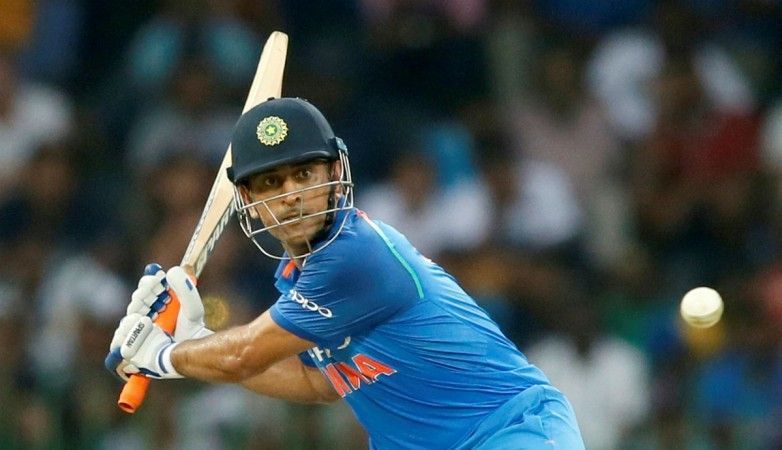
MS Dhoni's reverse gear turns out equally effective
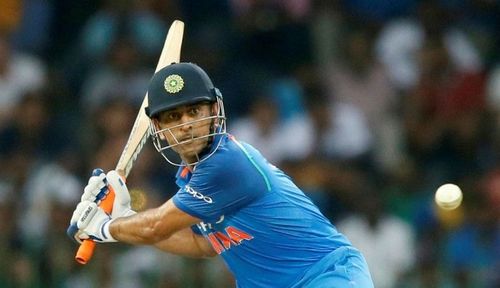
The last I had written about MS Dhoni was on the day he turned 36. The 'wine-like' comments had, in their propensity, drawn the attention towards the man who has craved for everything but. The 114-ball 54 in North Sound hadn't driven home the point for some as to how exactly was the wine getting better with time. That the man had put on the reverse gear to his methods of batsmanship and that they have been equally effective, although not in a manner most of us had been accustomed to, is the point I'll try to make here.
Chennai wasn't the first occasion in 2017 when Dhoni walked out to the middle with his side reeling, to put it modestly, after yet another catastrophic failure of the top order. I would discuss the record-shattering Sri Lanka series later. More importantly, however, Dhoni's record since January this year -- after having given up captaincy -- speaks less about the man's longevity, really, and more about how he's adapted to the role he was making confused attempts at when I'd last written about it.
It is not about the 624 runs that he's scored in 14 innings since the beginning of 2017 or about his magnanimous average of 89 or a more than acceptable strike-rate of 85.65. Rather, it has been about the way he's gone about getting these 624 runs and the circumstances under which he's scored them.
11/3 in Chennai can easily be related to 25/3 in Cuttack in the 2nd ODI vs England in January, in that India had lost their top three inside 15 overs. They're also similar considering that Dhoni's partners at the other end, on both occasions, had been scoring freely -- Yuvraj Singh in Cuttack and Hardik Pandya in Chennai.
While Dhoni has always been slow at the beginning of his innings, as one is expected to be in the aforementioned circumstances, it is his reliance on boundaries that has changed dramatically. It was not until the 67th ball he faced, after Pandya was dismissed, that he scored his first boundary in Chennai. Table 1 shows a breakdown of Dhoni's 79 in the 1st ODI in four 20-ball spells.
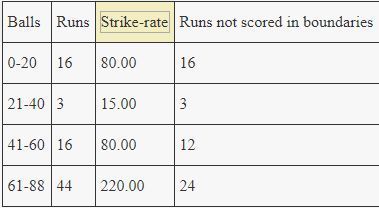
Table 1. Dhoni's 79 in Chennai broken down into spells
In the first two 20-ball spells, the percentage of runs scored in boundaries is 0%. However, in the next two 20-ball periods i.e., balls 41-60 and 61-88 (the last one being a 28-ball spell) that percentage rises to 25% and 45.4%, respectively. Table 2 shows the same breakdown of his innings of 134 in Cuttack.
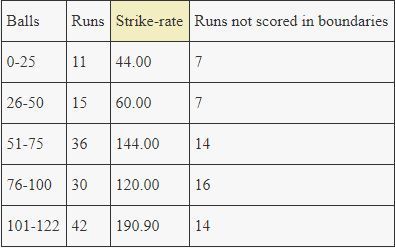
Table 2. Dhoni's 134 in Cuttack broken down into spells
Given that Dhoni was in in the 5th over of the innings, the percentage of runs scored in boundaries is positive right from the first 25-ball spell. In the first 25 balls, Dhoni scored 36.36% of his runs in boundaries. For the next two spells i.e., balls 26-50 and 51-75 that percentage was 53.33% and 61.11%, respectively. Towards the death, from balls 76-100 and 101-122, it was 46.67% and 66.67%, respectively.
The data presented here puts Dhoni's methods into context, more than his numbers. The slogger with no apparent technique now has a trigger movement and has successfully transitioned himself into an accumulator.
However, this isn't the change that we've seen as far Dhoni's methods are concerned. The change and a subtle one to be honest, (apart from the one which is already out in the open -- him not being the finisher of the yore) is him successfully adapting to the role of the accumulator.
That's been partly because of Pandya's success with the bat at No. 7 and Kedar Jadhav's utility at 6 and partly because Dhoni himself had admitted to his declining abilities as a finisher as far back as in the 2015 home series vs South Africa.
The nudges and jabs to the edge of the 30-yard circle and the occasional bunts to short midwicket or extra cover have become as important for the 36-year-old as have been those well-timed late cuts square of the wicket on the off side.
To verify, one of Dhoni's knocks from the mid-2010s has been considered here -- the last hundred he scored before Cuttack, the 139* against Australia in 2013. He had walked in at 76/4 in the 13th over, making this game quite similar to the two discussed above. Table 3 shows the spell-by-spell breakdown for this knock.
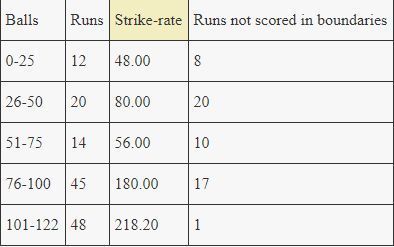
Table 3. Dhoni's 139* vs Australia (2013) broken down into spells
The percentage of runs scored in boundaries for each of the 25-ball spells are as follows: 33.33% for balls 0-25, 0% for 25-50, 28.50% for 51-75, 62.20% for 75-100, and 99% for balls 101-122. Table 4 puts these percentages into context by mapping Dhoni's last two ODI hundreds against each other.
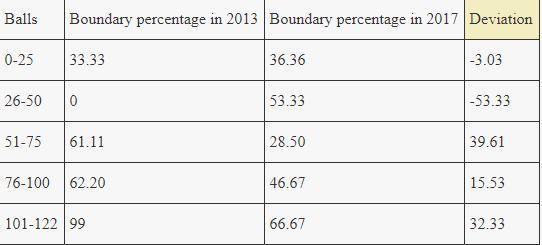
Table 4. Dhoni - deviation in boundary percentages
When this table is viewed with the data that the average number of boundaries per innings hasn't changed much since the beginning of 2015, or pretty much from any given point in his career, it helps reveal two conclusions. Dhoni has hit 153 boundaries from 41 innings @ 3.73 per innings since 2015 and had hit 804 boundaries from 219 innings @ 3.67 per innings from 2004-2014.
The deviation is positive in the last three rows of Table 4, which indicates that as compared to 2013, Dhoni has been hitting fewer boundaries as the innings approaches the death overs. However, since the overall boundary percentage is roughly the same, it should imply that he's been making up for them at the beginning of the innings.
That's hard to believe given the way he's had a no-no policy towards big shots early in his innings. Maybe the vast difference in sample space (41 innings vs 219 innings) has twisted the numbers.
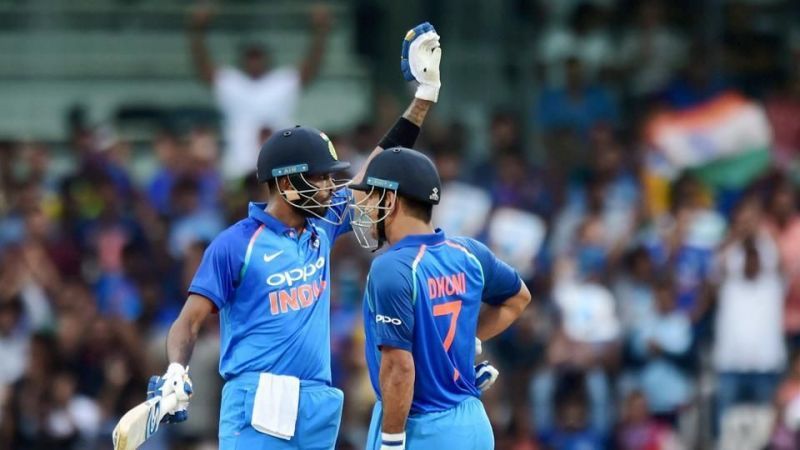
The certain conclusion that can be drawn is that Dhoni hasn't been as destructive (in terms of fours and sixes) as he had been before. But here's the catch. If he hasn't been scoring as many runs in boundaries but his average hasn't dropped, nor has his strike-rate, it means he's been getting those runs from other means.
That's how he's become the accumulator and the Sri Lanka ODI series was the prime example. Dhoni wasn't dismissed at all in the series and it was partly because he played low-risk cricket. That the match situations demanded him not to take many risks also worked in his favour.
In the 2nd ODI at Pallekele, India threw away a brisk start given by openers Rohit Sharma and Shikhar Dhawan, and were 131/7 in 22 overs, chasing 237. Dhoni's 45 off 68 contained only 1 four and was overshadowed by Bhuvneshwar Kumar's match-turning half-century. A strike-rate of 66.17 in a chase that demanded 106 off 28 overs with the team seven down was harmless.
Pandemonium ensued in the 3rd ODI as well, at the same venue, when India were reduced to 61/4 in the 16th over, chasing 218. Dhoni's 67 off 86 had 4 fours and 1 six. Again, it was overshadowed by Rohit's majestic 124. But Dhoni's knock was timely, effective and prevented another collapse, and by extension, a probable defeat.
These were pressure situations, the quality of the opposition regardless, and Dhoni was the perfect foil to Bhuvneshwar and Rohit, in his own jabbing, bunting and piercing manner. All the innings that have been discussed in this piece were played under pressure, which in turn underline Dhoni's unmatched ability to perform with his back against the wall.
However, this changed approach has backfired on occasions as well. Just like it did in North Sound, wherein he walked out at 47/3, with India chasing 190, stitched a 54-run partnership with Ajinkya Rahane but got out before he could switch to the less aggressive but equally effective mode towards the death. Wickets of Rahane, Jadhav, Pandya and Ravindra Jadeja falling around him didn't help his cause either.
Just like it happened in Delhi and Mohali against New Zealand in his last ODI series as captain, in October 2016. What happened in the Champions Trophy final was a team disaster. To put the blame of that loss on one man's shoulders would be unfair, especially in a pressure match such as an ICC-event final.
But all of this was a part of Dhoni's transition: a transition he had to go through to stay relevant in the team's plans, especially after a torrid 2016. That was the assassin trying hard to become the facilitator, and now that he's become one, there is a young blood in Pandya ready to take over.
Dhoni's still finishing games; well, most of them. It's just that the winning six -- a euphemism for dirty nostalgia, really, more than anything else -- hasn't been there. The home season, as well as the back-to-back away tours, would present tougher challenges than what he has faced since the beginning of this year, but just like it was unexpected of him to do this well, he might come up with something unorthodox.
He averages 89.57 in 2017 and is striking the ball just as well at 85.65. At 36, this isn't generally what you get from someone who's been around for 13 years. Pressure run-chases would still come about and the opposition wouldn't always be the beleaguered Sri Lanka of 2017.
What one can expect Dhoni to do in such situations is be the facilitator. Facilitator to the Jadhavs and Pandyas and to be a little optimistic, Bhuvneshwars. If all of them fail, he will nonchalantly take it upon himself to finish it off. He may still do it, he may never do it, but to put it with a sense of conviction, he wouldn't stop trying.
Just as he tried for approximately two years (since the 2015 South Africa series) to become an accumulator from an aggressor and finally succeeded. How many folks of the past do you think would have done this at 36? How many could have managed to bat in the reverse gear?